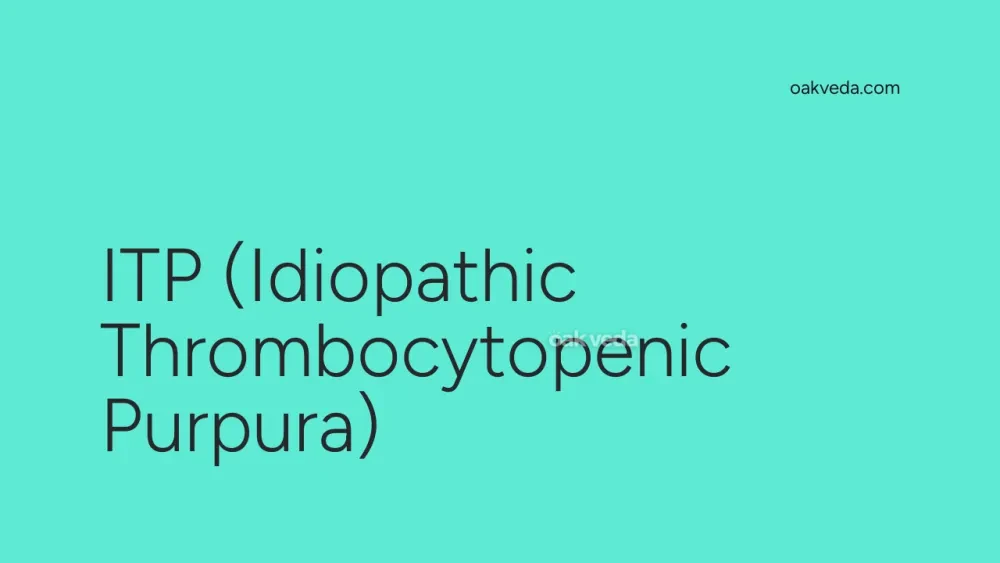
What is the Full Form of ITP?
The full form of ITP is Idiopathic Thrombocytopenic Purpura. This medical term describes a rare autoimmune bleeding disorder characterized by a significant decrease in blood platelet count. ITP is also known as Immune Thrombocytopenic Purpura, reflecting the immune system's role in the condition.
What is Idiopathic Thrombocytopenic Purpura?
Idiopathic Thrombocytopenic Purpura is a blood disorder where the immune system mistakenly attacks and destroys platelets, the blood cells responsible for clotting. This results in an abnormally low platelet count, leading to an increased risk of bleeding and bruising. The term "idiopathic" means the cause is unknown, "thrombocytopenic" refers to low platelet count, and "purpura" describes the purple-colored spots on the skin caused by bleeding under the surface.
Origin and Development of ITP
The exact cause of ITP remains unknown, hence the term "idiopathic." However, researchers have identified several factors that may contribute to its development:
- Autoimmune response: The immune system produces antibodies that attack and destroy platelets.
- Genetic factors: Some individuals may have a genetic predisposition to developing ITP.
- Viral infections: Certain viral infections may trigger the onset of ITP, especially in children.
- Medications: Some drugs can induce thrombocytopenia as a side effect.
How does ITP work?
In ITP, the immune system malfunctions and produces antibodies that target platelets. These antibodies attach to platelets, marking them for destruction by the spleen. As a result, platelets are removed from circulation faster than the body can produce them, leading to a low platelet count. This process impairs the blood's ability to clot effectively, increasing the risk of bleeding and bruising.
Types of ITP
ITP is generally classified into two main types based on the duration of the condition:
-
Acute ITP: This form typically affects children and lasts for less than six months. It often resolves on its own without long-term complications.
-
Chronic ITP: More common in adults, chronic ITP persists for six months or longer. It requires ongoing management and may have a more significant impact on quality of life.
Functions of Platelets in ITP
Understanding the role of platelets helps to appreciate the impact of ITP on the body:
- Blood clotting: Platelets are crucial for forming clots to stop bleeding.
- Wound healing: They release growth factors that promote tissue repair.
- Maintaining blood vessel integrity: Platelets help seal small breaks in blood vessel walls.
In ITP, these functions are compromised due to the low platelet count.
Applications of ITP Research
Research into ITP has broader applications in the field of hematology and immunology:
- Understanding autoimmune disorders
- Developing new treatments for platelet disorders
- Improving diagnostic techniques for blood disorders
- Advancing knowledge of the immune system's role in blood cell production
Features of ITP
Key features of Idiopathic Thrombocytopenic Purpura include:
- Low platelet count (typically below 100,000 per microliter of blood)
- Increased bleeding tendency
- Autoimmune nature
- Variable course of disease (can be acute or chronic)
- Higher prevalence in women than men
- Can affect all age groups, but peaks in childhood and adulthood
Benefits of Early ITP Diagnosis
Early diagnosis and management of ITP offer several benefits:
- Reduced risk of severe bleeding episodes
- Improved quality of life
- Prevention of complications
- Tailored treatment plans
- Better long-term outcomes
Limitations or Challenges of ITP Management
Managing ITP comes with several challenges:
- Unpredictable disease course
- Potential side effects of treatments
- Impact on daily activities and lifestyle
- Psychological burden of a chronic condition
- Need for ongoing monitoring and medical care
Future Developments in ITP Treatment
Research in ITP is ongoing, with promising developments on the horizon:
- Novel targeted therapies
- Improved understanding of disease mechanisms
- Personalized treatment approaches
- Gene therapy potential
- Enhanced diagnostic tools for early detection
FAQs on ITP Full Form
Q1: What are the common symptoms of ITP? A1: Common symptoms include easy bruising, petechiae (small red or purple spots on the skin), prolonged bleeding from cuts, nosebleeds, and heavy menstrual periods in women.
Q2: How is ITP diagnosed? A2: Diagnosis typically involves a complete blood count (CBC), physical examination, and sometimes a bone marrow biopsy to rule out other causes of low platelet count.
Q3: Can ITP be cured? A3: While there is no cure for chronic ITP, many patients can achieve remission with appropriate treatment. Acute ITP, especially in children, often resolves on its own.
Q4: What treatments are available for ITP? A4: Treatment options include corticosteroids, immunoglobulins, thrombopoietin receptor agonists, and in some cases, splenectomy (surgical removal of the spleen).
Q5: Is ITP a form of cancer? A5: No, ITP is not a form of cancer. It is an autoimmune disorder affecting platelet production and survival.
In conclusion, understanding the full form of ITP - Idiopathic Thrombocytopenic Purpura - is crucial for patients, caregivers, and healthcare professionals. This complex autoimmune disorder requires careful management and ongoing research to improve outcomes for those affected. As our knowledge of ITP grows, so does the hope for more effective treatments and potentially a cure in the future.
You may be interested in:

